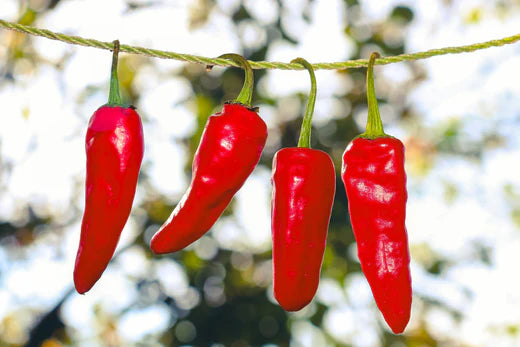Chili pepper, often known as cayenne pepper, is frequently used to flavor food. It is a variety of capsicum that matures to a length of 10 to 25 cm. This herb has a curved tip, is slender, and primarily has a red tint. It hangs from the bush with rippling skin. To utilize these chiles in cooking, they are picked, dried, and pounded into a powder. When cooking, it is used to provide a spicy flavor to the food. In addition, cayenne pepper is a well-known herbal supplement with a wealth of therapeutic benefits. Despite being named pepper, it does not belong to the piper genus like black pepper. The name "capsicum" is derived from a Greek verb that means "to bite".
General Description
Small shrubs or plants called cayenne typically flourish in tropical climates. As a biennial or annual shrub, this herb has a long lifespan. Like annuals, this herb is grown in northern regions. Although its vivid red fruit is frequently mistaken for a vegetable, it is actually a fruit. It tastes bitter and is potently hot. Capsaicin, a cayenne pepper component, gives the spice its prickly and hot flavor. The quantity varies depending on the herb's species. The vivid red color of this fruit draws birds, who are unaffected by its fiery and spicy flavor. These birds also spread the seeds of this plant. Cayenne is a highly potent spice, yet it has a balanced energy level and can be used for a long period of time as food. It contains capsaicin, which has analgesic properties that assist in treating a variety of ailments including joint pain, muscular aches, and headaches. A slight burning sensation may result from its topical treatment. Soups with cayenne pepper should be drunk when you have a cold or cough. It aids in healing the illnesses. Its powder can be used to treat bug and snake bites as well as aid the body in ridding itself of poisons. It promotes wound healing when applied to the injured region.
Common Name- Cayenne, Capsicum, Hot pepper, Tobasco, Spur pepper, Chili pepper, Chili
Botanical Name- Capsicum annuum
Family- Solanaceae
Potency- Hot and acrid
Preparations of Cayenne Pepper
Cayenne pepper is mainly used as a spice in food preparation to give meals a hot flavor. It can also be applied as a salve, liniment, oil, or fomentation.
Medicinal Properties
Antimicrobial
Stimulant
Analgesic
Immunomodulator
Carminative
Expectoration Inducer
Antioxidant
Diaphoretic
Antifungal
Rubefacient
Maintains blood circulation
Digestive
Metabolic stimulant
Anti-irritant
Therapeutic Uses of Cayenne Pepper
- Cayenne pepper may be scorching and bitter, but to your surprise, it also soothes bodily irritability. Due to its anti-irritant properties, it can help alleviate stomach upset, cough, sore throat, and diarrhea brought on by irritation brought on by sickness, food, or environmental contaminants.
- Due to its expectorant properties, this herb helps the body expel the clogged mucus that accumulates during a catarrhal condition. It can be applied to treat different allergies and congested sinuses.
- It functions as a remarkable natural defense against numerous hazardous organisms and guards against illnesses and infections. Chemical components in it prevent hazardous organisms from functioning.
- Cayenne works as an analgesic to help with headache relief. According to research, this is because this herb has the initial potential to cause pain, which causes the brain to focus on the new site of discomfort. Depletion of the nerve's pain chemical results in pain relief.
- This spice, which is well-recognized for stimulating the digestive tract and increasing the flow of digestive fluids and enzymes, can help with digestion. This phenomenon facilitates better digestion.
- Enhancing the peristaltic motions of the intestines assists in reducing intestinal gas and aids in the digestion and removal of meals.
- Its anti-inflammatory characteristics treat inflammation and the symptoms it causes, including redness, discomfort, and swelling of the affected area. Cayenne is a fantastic plant for reducing cellular stress throughout the body.
- This herb enhances saliva production by stimulating the salivary gland, which is crucial for digestion and dental health.
- Due to its fibrinolytic action, it has cardiovascular protective characteristics that aid in the treatment and prevention of a number of illnesses, including atherosclerosis, thrombosis, and embolism. All of these reduce the risk of developing cardiac problems.
- As a natural detoxifier, cayenne helps the body get rid of poisonous chemicals and free radicals, preventing oxidative damage. Due to its heated activity, it induces perspiration, which is one way to detoxify the body.
- Because capsaicin, a naturally occurring chemical ingredient, is present, it sends chemical signals to the joints that temporarily ease the pain. Thus, it is present in many creams and lotions that are intended to treat pain.
- Since it stops bacteria from contaminating the food, cayenne can be used as a natural preservative.
- According to studies, consuming this fruit regularly lengthens life compared to those who don't. Additionally, it lowers the chance of cancer, respiratory illnesses, cardiovascular disorders, and other major health conditions.
- .Cayenne in the morning reduces hunger, which results in fewer calories consumed and healthy weight loss. Additionally, it helps the body burn off additional fat.
- It improves blood flow to the heart, reducing the risk of numerous heart disorders.
- The pain can be naturally relieved by applying cayenne to the area where the tooth hurts.
- It can also be applied topically for a variety of conditions, including lumbago, lower back pain, ulcers, sores, and snake bites.
Parts Used
Fruits and seeds

